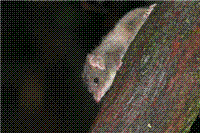Family
Dasyuridae
Genus
Antechinus
Species
agilis
Threats/Control Methods - Regional
Land clearing, exotic tree plantations, native forestry actions and bushfires are threatening the previous abundance of this species. Feral cats (Felis catus ), foxes (Vulpes vulpes ) and various owl species are known predators of the Agile Antechinus.
Threats/Control Methods - Local
The continuing loss of mature trees and native forests from around the ACT suburbs is limiting the available nesting and foraging resources.
Common name/s
Agile Antechinus
Distinguishing Features
This fairly small marsupial has a head and body length of around 10cm and a tail of the same length. Their fur is a grey brown colour above and a lighter grey underneath. The dark eyes are large and prominent, as are the round, pink-grey ears. The tail is thin with some fur and the feet are lighter coloured than the rest of the animal.
Species Call
Mothers give a soft ©chit© cry to their young, to which a weak ©siss© cry is given from the nestlings. Adults displaying aggression make more intense ©siss© cries.
Similar Species
This species is often confused with the larger Brown Antechinus (Antechinus stuartii). From a distance, it may also be confused for a Black Rat (Rattus rattus ) or Bush Rat (Rattus fuscipes ).
Distribution
The range of this species is restricted to the southeastern half of Victoraia and the most southern areas of NSW, along the south coast and inland to an altitude of 2000m.
Country of Origin
Australia
Survey Techniques
Trapping
Conservation (Pet/Pest) Status - National
Secure, not listed under the EPBC Act 1999. It may be considered a pest in some household environments.
Associated vegetation community
This species inhabits a range of forest environments. They are also found in urban areas with links to nearby native vegetation.
Limiting Resources
This species depends upon hollow trees and logs on the forest floor for nesting and foraging resources. It requires a constant supply of native food in order to maintain normal breeding behaviour. Predation and decreases habitat limit this species ability to maintain strong population numbers.
Breeding
The mating period lasts for a few weeks in winter, ending with the death of all males. Females give birth to a litter of six to ten young after a gestation period of 27 days. These tiny creatures survive in their mother's pouch for five weeks, before moving into a leaf-lined nest in a low-lying tree hollow. Here they are feed from their mother's milk for a further 3 months. After this time, young males disperse into a new territory, while the females to not move far.
Behaviour
This species is known for its acrobatic skills and great climbing ability. It often has to chase its prey, darting around quickly to secure a meal. This generally occurs at night, as this marsupial is mostly nocturnal. If food is scarce, some foraging may happen during the day. Wintertime food scarcities may cause the species to become dormant. During most of the year, adult Antechinuses nest together in groups of about 20 individuals.
Functional Group
Food Species
The Agile Antechinus prefers large beetles, spiders and cockroaches, while small lizards and soft berries are eaten occasionally.
Predators
Feral cats (Felis catus ), foxes (Vulpes vulpes ) and various owl species are known predators of the Agile Antechinus.
Interesting Fact
The Agile Antechinus was only recognised as a unique species to the Brown Antechinus (Antechinus stuartii) in recent years. The scientific species name 'agilis' was adopted from its nickname Agile Antechinus, due to its swift movements and acrobatic climbing ability.
References - (reader suitability of references, P=Primary teachers, S=Secondary students, T=Tertiary students and researchers)
Books:Strahan, R. (ed.) 1995. The Mammals of Australia. Australian Museum Trust/Reed Books. Chatswood NSW. P, S, T
Online Publications:Tidemann, C., Roscoe, T. and Mitchell, B. 2006. Mammals of the Lower Sullivans Creek Catchment, Canberra ACT. Prepared for the Life in the Suburbs project using data from the Lower Sullivans Creek Catchment Ecological Survey (LSCCES). Australian National University. Canberra. [online]. Available at: http://www.lifeinthesuburbs.com.au/category.php?id=65 S, T
Researcher: Naomi Hogan

 Top
Top Top
Top